
Crocus is a genus of seasonal flowering plants in the family Iridaceae comprising about 100 species of perennials growing from corms. They are low growing plants, whose flower stems remain underground, that bear relatively large white, yellow, orange or purple flowers and then become dormant after flowering. Many are cultivated for their flowers, appearing in autumn, winter, or spring. The flowers close at night and in overcast weather conditions. The crocus has been known throughout recorded history, mainly as the source of saffron. Saffron is obtained from the dried stigma of Crocus sativus, an autumn-blooming species. It is valued as a spice and dyestuff, and is one of the most expensive spices in the world. Iran is the center of saffron production. Crocuses are native to woodland, scrub, and meadows from sea level to alpine tundra from the Mediterranean, through North Africa, central and southern Europe, the islands of the Aegean, the Middle East and across Central Asia to Xinjiang in western China. Crocuses may be propagated from seed or from daughter cormels formed on the corm, that eventually produce mature plants. They arrived in Europe from Turkey in the 16th century and became valued as an ornamental flowering plant.

Iris is a flowering plant genus of 310 accepted species with showy flowers. As well as being the scientific name, iris is also widely used as a common name for all Iris species, as well as some belonging to other closely related genera. A common name for some species is flags, while the plants of the subgenus Scorpiris are widely known as junos, particularly in horticulture. It is a popular garden flower.

Freesia is a genus of herbaceous perennial flowering plants in the family Iridaceae, first described as a genus in 1866 by Christian Friedrich Ecklon (1886) and named after the German botanist and medical practitioner, Friedrich Freese (1795-1876). It is native to the eastern side of southern Africa, from Kenya south to South Africa, most species being found in Cape Provinces. Species of the former genus Anomatheca are now included in Freesia. The plants commonly known as "freesias", with fragrant funnel-shaped flowers, are cultivated hybrids of a number of Freesia species. Some other species are also grown as ornamental plants.

Iridaceae is a family of plants in order Asparagales, taking its name from the irises. It has a nearly global distribution, with 69 accepted genera with a total of c. 2500 species. It includes a number of economically important cultivated plants, such as species of Freesia, Gladiolus, and Crocus, as well as the crop saffron.
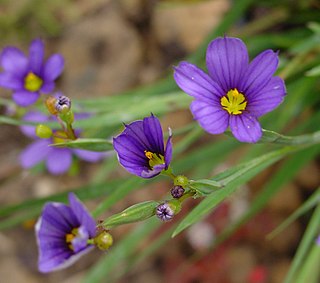
Sisyrinchium is a large genus of annual to perennial flowering plants in the family Iridaceae. Native to the New World, the species are known as blue-eyed grasses. Although they are not true grasses (Poaceae), they are monocots.

Iris pseudacorus, the yellow flag, yellow iris, or water flag, is a species of flowering plant in the family Iridaceae. It is native to Europe, western Asia and northwest Africa. Its specific epithet pseudacorus means "false acorus", referring to the similarity of its leaves to those of Acorus calamus, as they have a prominently veined mid-rib and sword-like shape. However, the two plants are not closely related. The flower is commonly attributed with the fleur-de-lis.

Dietes iridioides, commonly named African iris, fortnight lily, and morea iris, is a species of plant in the family Iridaceae that is native to Southern Africa.
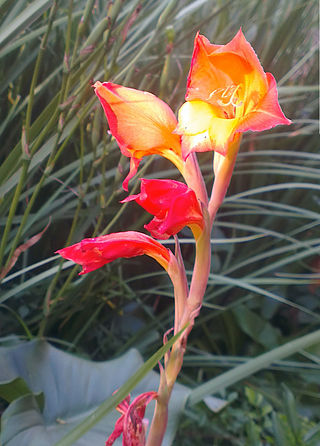
Gladiolus dalenii is a species of flowering plant in the iris family Iridaceae. It is one of the most widely distributed species of Gladiolus, ranging from eastern South Africa and Madagascar throughout tropical Africa and into western Arabia. It is the main parental species of the large flowering grandiflora hybrids. This species is also unusual in its genus in including diploid, tetraploid and hexaploid races. The hybrids produced from it are often tetraploids.

Trimezieae is a tribe included in the subfamily Iridoideae of the family Iridaceae. It is the smallest tribe in this subfamily, containing only three closely related genera.
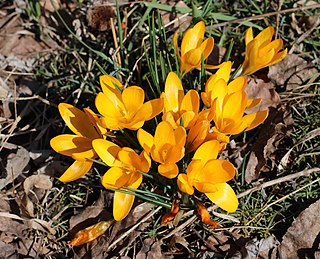
Crocus flavus, known as yellow crocus, Dutch yellow crocus or snow crocus, is a species of flowering plant in the genus Crocus of the family Iridaceae. It grows wild on the slopes of Greece, former Yugoslavia, Bulgaria, Romania and northwestern Turkey, with fragrant bright orange-yellow flowers. It is a small crocus (5–6 cm, despite the names of some cultivars, compared to the giant Dutch crocuses. Its cultivars are used as ornamental plants.

Ixia maculata is a species of flowering plant in the family Iridaceae known by the common name spotted African corn lily. It is native to the Cape Provinces of South Africa, but it is grown widely as an ornamental plant. It can also be found growing wild as an introduced species in several areas, including Western Australia. This perennial flower grows 20 to 70 centimeters tall with an erect, unbranched stem. There are a few twisting basal leaves up to 35 centimeters long. The inflorescence is a dense, showy spike of up to 12 flowers, usually orange to yellow in color, sometimes with areas of purple or red and often with spots; the coloration in garden plants varies due to breeding.
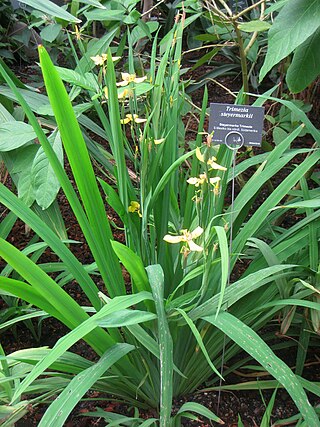
Trimezia steyermarkii is a species of flowering plant in the family Iridaceae, native to southern Mexico, Central America, Colombia, and Venezuela. Plants are up to 150 cm tall, with rhizomes up to 2–4 cm long and 2–3 cm wide; leaves are lanceolate, 60–150 cm long by 2 cm wide; flowers are yellow with brown spots. In countries like Colombia and Venezuela one of common names that is often given to this plant is "Hand of God" because of the three flower petals.
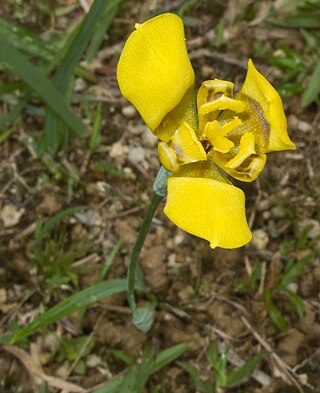
Trimezia martinicensis is a species of bulbous plant in the family Iridaceae. Originally from South America and the West Indies, it is now widely naturalized throughout the tropics. Common names include Martinique trimezia, yellow walking iris and forenoon yellow flag.

Trimezia northiana, synonym Neomarica northiana, also known as North's false flag or walking iris, is a flowering plant, native to Brazil, with a rhizomatous rootstock, belonging to the iris family, Iridaceae.

Iris subbiflora is a plant species in the genus Iris, it is also in the subgenus Iris. It is a rhizomatous perennial, from Portugal and Spain in Europe. It has evergreen broad leaves, forming dense clumps, it has dwarf stems in late spring,, with 1 upright fragrant flower, in shades of purple, light red purple, grey-blue, blue-violet, or dark violet. It has a beard which is generally blue, purple, or violet, but can fade to white, dull yellow, or dark yellow. After being found in 1804, it was once a separate species until the late 70s, when it was reclassified as subspecies of Iris lutescens, and renamed Iris lutescens subsp. subbiflora. But in the 80s it was returned to an independent species but some authors and references still class the species as a synonym or subspecies. It is cultivated as an ornamental plant in temperate regions.

Romulea tortuosa is a herbaceous perennial geophyte in the family Iridaceae native to South Africa. It has a small corm in the soil, a few prostrate coiling leaves, and fragrant, trimerous yellow flowers, sometimes with six brown blotches on the inside near the bottom of the flower.

Romulea columnae, the sand crocus, is a herbaceous perennial in the family Iridaceae. It is a small plant, with thin narrow leaves, and small scape which has small pink, pale purple or violet pointed flowers with darker veining and a gold or yellow throat. It is native to a wide area ranging from western Europe to the Mediterranean.

Tulipa fosteriana is a species of tulip, native to the Pamir Mountains and nearby areas of Afghanistan, Kyrgyzstan, Tajikistan and Uzbekistan.

Trimezia humilis is a species of bulbous plant in the family Iridaceae. Native to Venezuela and parts of Brazil. The species was originally named Cypella humilis by Friedrich Wilhelm Klatt in 1862. Pierfelice Ravenna then moved the species into the genus Trimezia in 1977.

Trimezia candida, synonym Neomarica candida, also known as white walking iris, is species of flowering plant. It was first described by Emil Hassler and given the name Neomarica candida by Thomas Archibald Sprague. Trimezia candida belongs to the genus Trimezia and family Iridaceae.



















